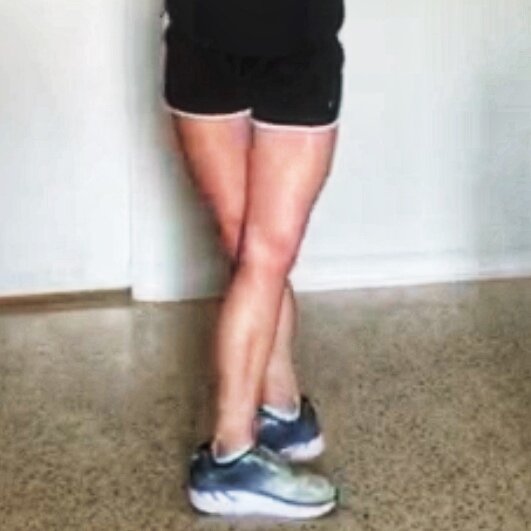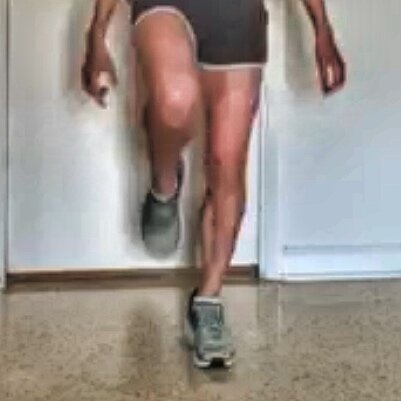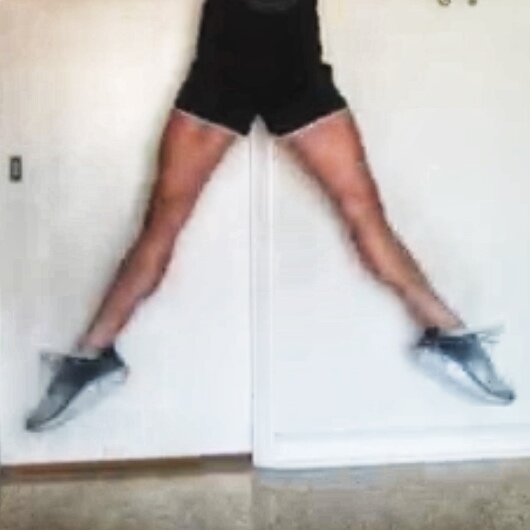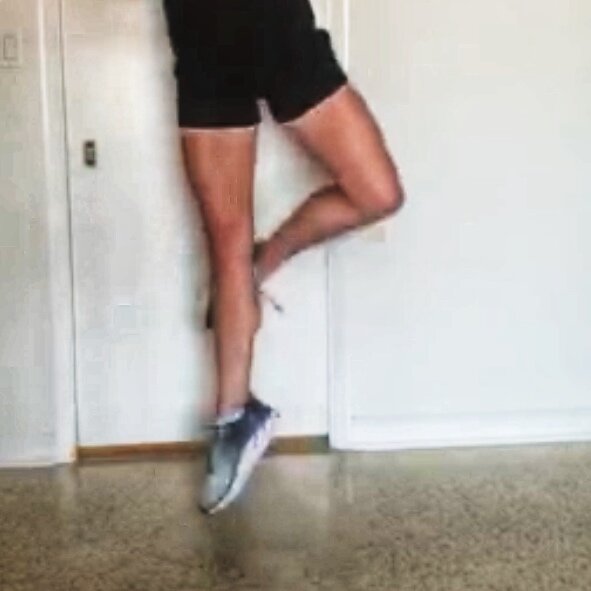Staying One Jump Ahead
Plyometric training for dancers
When it came to ballet class as a kid I could work on turn combinations all day long but jumping always felt like work. It wasn’t until I really dove into modern technique where I had to build different strength into my legs that jumps in ballet began to feel effortless. Looking back now I wish that I discovered the importance of balanced strength in the muscles around my core, pelvis and hips along with the benefits of plyometric training earlier in my dance career.
With the current space limitations that many dancers face while staying safe at home, plyometric training may be the best way to keep your lower body strong and ready to return to jumps once our studios reopen.
What is a plyometric program?
By definition a plyometric is an activity that involves repeated rapid stretching and contracting of muscles to increase power. The rapid contraction of your muscles and tendons elastic components along with the stretch reflex creates a maximal force in the shortest amount of time. While the muscle is being stretched (eccentric loading) it stores the elastic energy that is created, this stored energy allows the muscle to produce a greater force than just a concentric (shortening) contraction alone. By training your body to quickly transition between the stretch and shortening (amortization phase) you capitalize on the stored energy and improve overall speed and power of your jumps. Noticeable gains from plyometric training can be seen in as little as 4 weeks, with maximum gains being seen around 8 weeks. This makes the off season, or staying safe at home, the best time to add in a plyometric program.
Plyometrics can be applied to any muscle in the body, yet they are most commonly used in developing explosive power and improved speed in the lower body. While lower extremity plyometrics are helpful across all dance forms plyometrics can also help to create strength and speed in the upper body for partnering as well as full body integration that is vital in modern and contemporary work.
In dance lower extremity plyometrics are built into almost every ballet class with jump combinations, while modern and contemporary classes will also build in full body integration. Adding a traditional plyometric program along with a dance specific program allows the dancer to create balanced musculature and avoid overuse injuries commonly seen from jumping.
Factors in Developing a Plyometric Program:
Contraindications:
If you have pain, inflammation or significant joint instability please seek medical guidance before adding plyometrics into your program
Intensity
Plyometrics increase the level of stress on the muscles, tendons, ligaments and joints.
The intensity of a plyometric program can be graded through the speed, amount of contacts, and the level of impact that the body is absorbing.
Example- Skipping is low intensity, but jump downs from a box (depth jump) are a higher intensity
Other factors that should be considered are the points of contact (two feet or one foot) along with body weight.
High level exercises can cause forces that are 3-4 times your body weight
When developing a place the intensity should be determined based on your
Experience- are you a beginner dancer or a more experienced professional dancer
Age- are you a youth dancer who is still growing or a dancer who has been struggling with more injuries- consider starting with a lower intensity program
in season or off season- during the off season when your body has less built up fatigue you can complete a higher intensity program. In season you want to still add in a plyometric program to maintain the level that you built up.
Frequency (sessions per week)
depends on the time in the training cycle and the sport.
In season- 1-2 sessions a week will help you to maintain your level.
Off season- plyometrics can be included into conditioning programs 3-4 days a week.
Recovery
The goal of recovery in a plyometric workout is to gain a complete and adequate recovery during reps, sets and workouts.
The specific recovery time depends on the intensity, frequency and volume.
Focus on your form during a workout, if you start to lose power, or your form is falling apart it is better to stop and rest than push through an exercise.
If during your next plyometric day you are not able to perform at the same level you need to take another day to recover.
Average time between plyometric sessions should be 48-72 hours
Duration
Program duration depends again on athletic experience, age, and timing with the training cycle
The best time to start a plyometric program is during the off season and should last approximately 8-12 weeks to see the maximum benefit.
Actual duration of any given workout is dependent upon how many reps are planned and how much rest is required for recovery between sets
Progression
You want to slowly increase you plyometric program by approximately 10% per week
Work in 3 week cycles with 2 weeks of building and then 1 week of recovery
Recovery weeks should be 50% of the previous weeks volume
Week 1- 100 reps
Week 2- 110 reps
Week 3- 55 reps
Week 4- 110
During the recovery week you can still maintain or slightly increase the intensity
What level do you need to be at to begin plyo program
A plyometric program can be developed for dancers of any level.
All programs should be tailored to the specific dancer based on their needs, age, history, and current level.
Building a Lower Extremity Plyometric program
The six main forms of lower body plyometrics are:
Jumps in Place
Standing Jumps
Multiple Hops and Jumps
Bounds
Box Drills
Deep Jumps
How to develop a plyometric program
An off-season plyometric program could be three days per week for beginners and four days per week for advanced athletes.
The sessions should be on non-consecutive days alternating low intensity plyometrics exercises with high intensity plyometrics exercises.
In-season plyometric program- some level of plyometric training is built into class with all jump combinations.
Most high level dancers may want to add some more advanced plyometric jumps 1-2x/week to increase power and strength
Set your total plyometric volume according to your experience, remembering that every time your foot contacts the ground, it counts as a repetition:
Beginner: 100 to 120 reps
Intermediate: 120 to 140 reps
Advanced: 140 to 160 reps
Dancer: 200 to 220 reps
Based on average contacts for a dancer
Progression of a program should also help to load the muscles and joints appropriately.
2 feet to 2 feet (2:2)
1 foot to 2 feet (1:2)
1 foot to 1 foot (1:1)- alternating feet, single leg
2 feet to 1 foot (2:1)
Footwear
All traditional plyometric programs should be completed in sneakers.
Ballet specific plyometric programs can be completed in ballet shoes if you are on a sprung floor.
If you are new to plyometrics or are completing them on a hard floor, unsprung floor, or slick floor you should complete the program in sneakers
If ballet specific jumps brush the floor modify the jump so that you do not jam or catch your foot on the floor.
Technique
I recommend taking a video when you begin a plyometric program so that you can review the following:
Alignment- Is the dancer able to maintain the correct alignment through the entire lower kinetic chain during all plyometric exercises.
Timing- Are the segments moving at the correct time or is there a lag in the movement.
Control- Is the dancer able to create the appropriate dynamic support around the joint allowing for stability the movement
Coordination- are all the muscles firing the way they are supposed to allowing for efficient movement patterns.
Sample Plyometric Programs
Traditional plyometric program
Warm-up (50 contacts/130 contacts)- Add 30 seconds rest between sets
Double foot jumps x10
Side to side variation x10
Front to back variation x10
Marching in place with high knees x10
Butt kickers x10
Main set
Intermediate (40 Contacts 90/130 contracts)- Add 30 seconds rest between sets
Squat jumps x10
Lateral bounding x10
Alternating lunge jumps x10
Single leg side/side hop x10
Advanced (40 contacts/ 130 contacts)- Add 1 minute rest between sets
Froggers x10
Reverse lunge with knee up x10
Lateral lunge with curtsey squat
Tuck jump x10
Cool down
Make sure to stretch out Quads, hip flexors, hamstrings, gluts and calves
Stretches should be held for ~30 seconds-1 minute
Foam roll- focus on calves and quads or areas of tightness
I recommend finding a tight area and holding there for 20-3o seconds than moving onto next area
If you have increased soreness or tightness take another day to recover. Do not try and push through pain or discomfort and risk injury
Dance Specific Plyometric Program
Warm-up (20/160)
Plie releve (x30)
Two feet, two feet to one foot, single leg
Lunge push off (x40- 20 on each foot)
Front and side
Prances (x10 on each foot) ← count toward contacts
Intermediate (40/160)- 30 seconds rest in between exercises
Sauté in 1st and second positions (2 Feet) (x10 each position)
Focus on height
Assemble side(1:2) (x10)
Focus on height
jete (1:1)- alternating feet (x10)
Focus on suspending in air and solid landing
Advanced (80/160) 45 seconds to 1 minute rest between exercises
Soubresaut forward/backward (2:2) (x10)
Can add beats here to advance further
Focus on traveling
Glissade (1:1)
Side (x10)
front/ back (x10)
Focus on
Jete, sauté (1:1) (x20)
Focus on jumping as high as possible
Sissone (2:1)
Forward/backward (x10)
Side (x10)
Focus on traveling and splitting the legs and holding the one foot landing
Cool down
Make sure to stretch out Quads, hip flexors, hamstrings, gluts and calves
Stretches should be held for ~30 seconds-1 minute
Foam roll- focus on calves and quads or areas of tightness
I recommend finding a tight area and holding there for 20-3o seconds than moving onto next area
If you have increased soreness or tightness take another day to recover. Do not try and push through pain or discomfort and risk injury
If you have any questions regarding the above programs please contact us at Thedancedocs@gmail.com.
Here’s to staying one jump ahead!
In Health,
Dr. Kat Bower PT
The topics discussed on The Dance Docs Blog are for educational purposes only and are not intended to be medical or professional advice. All personal medical decisions should be discussed in full with your physician or appropriate medical professional before attempting any changes. Before adding additional training into your program please consult with the appropriate medical professional or movement specialist.



